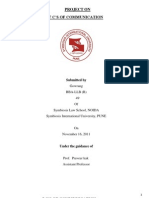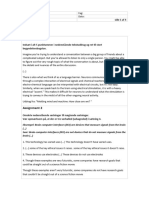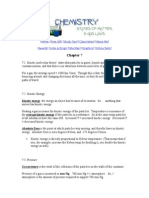Problem Set
Problem Set
Uploaded by
Fathir Karaeng CaddiCopyright:
Available Formats
Problem Set
Problem Set
Uploaded by
Fathir Karaeng CaddiOriginal Description:
Copyright
Available Formats
Share this document
Did you find this document useful?
Is this content inappropriate?
Copyright:
Available Formats
Problem Set
Problem Set
Uploaded by
Fathir Karaeng CaddiCopyright:
Available Formats
Text 1 A great deal of todays office activity involves the use of computers for communicating the written word
in networks or with data banks or with other computers outside the business organization originating the communicating. Until recently this communication ___(1)___ to the typed word. However, todays computer ___(2)___ by the human voice (called voice input) and material ___(3)___ into the computer with oral commands. The voice input is able to tell the computer what to do and how to do it. ___(4)___ the voice input can provide the information that is to be described into a written ___(5)___ a letter, a memorandum, a report, or some form of telecommunication. In other words, with voice activated computer software you will be able to dictate a letter to the computer and tell it what style to use, how many copies to make, and how the letter is to be sent. It may even do the actual transmitting. As voice activation for computers is further developed, effective oral communication will become more and more important. 1. A. is limited B. has been limited C. was limited D. was being limited E. had been limited 2. A. may be activated B. should be activated
C. had better be activated D. must be activated E. would rather be activated 3. A. inserted B. inserting C. to be inserted D. to be inserting E. it is inserting 4. A. nevertheless B. therefore C. furthermore D. however E. in conclusion 5. A. receipt B. bill C. document D. certificate E. order
Text 2 Human memory, formerly believed to be rather inefficient, is really more sophisticated than that of a computer. Researchers approaching the problem from a variety of points of view have all concluded that there is a great deal more stored in our minds than has been generally supposed.
Dr. Wilder Penfield, a Canadian neurosurgeon, proved that by stimulating their brains electrically, he could elicit the total recall of specific events in his subjects lives. Even dreams and other minor events supposedly forgotten for many years suddenly emerged in detail. The memory trace is the term for whatever is the internal representation of the specific information about the event stored in the memory. Assumed to have been made by structural changes in the brain, the memory trace is not subject to direct observation but is rather a theoretical construct that we use to speculate about how information presented at a particular time can cause performance at a later time. Most theories include the strength of the memory trace as a variable in the degree of learning, retention, and retrieval possible for a memory. One theory is that the fantastic capacity for storage in the brain is the result of an almost unlimited combination of interconnections between brain cells, stimulated by patterns of activity. Repeated references to the same information support recall. Or, to say that another way, improved performance is the result of strengthening the chemical bonds in the memory. 6. With what topic is the passage mainly concerned? a. Wilder Penfield b. Neurosurgery c. Human memory d. Chemical reactions e. Memory
7. The word formerly in line 1 could best be replaced by _____. a. In the past b. From time to time c. In general d. By chance e. In the future 8. Compared with a computer, human memory is ______. a. More complex b. More limited c. Less dependable d. Less durable e. Not complex 9. According to the passage, researchers have concluded that _____. a. The mind has a much greater capacity for the memory than was previously believed b. The physical basis for memory is clear c. Different points of view are valuable d. Human memory is inefficient e. Human memory is not valuable 10. How did Penfield stimulate dreams and other minor events from the past? a. By surgery b. By electric stimulation c. By repetition d. By chemical stimulation
e. By stimulation Text 3 Although speech is the most advanced form of communication, there are many ways of communicating without using speech. Signals, signs, symbols, and gestures may be found in every known culture. The basic function of a signal to impinge upon the environment in such a way that it attracts, as, for example, the dots and dashes of a telegraph circuit. Coded to refer to speech, the potential for communication is very great. Less adaptable to the codification of words, signs also contain meaning in and of themselves. A stop sign or barber pole conveys meaning quickly and conveniently. Symbols are more difficult to describe than either signals or signs because their intricate relationship with the receivers cultural perceptions. In some cultures, applauding in a theatre provides performers with an auditory symbol of approval. Gestures such as waving and handshaking also communicate certain cultural messages. Although signals, signs, symbols, and gestures are very useful, they do have a major disadvantage. They usually do not allow ideas to be shared without the sender being directly adjacent to the receiver. As a result, means of communication intended to be used for long distances and extended periods are based upon speech. Radio, television, and the telephone are only a few. 11. Which of the following would be the best title for the passage? a. Signs and signals b. Gestures
c. Communication d. Speech e. Television 12. According to the passage, what is a signal? a. The most difficult form of communication b. A form of communication which may be used across long distances c. A form of communication that interrupts the environment d. The form of communication most related to cultural perceptions e. The form of communication which is not useful 13. The word potential in bold type could be best replaced by which of the following? a. Range b. Advantage c. Organization d. Possibility e. Function 14. Applauding was cited as an example of _____. a. A signal b. A sign c. A symbol d. A gesture e. A communication 15. It may be concluded from this passage that _____. a. Signals, signs, symbols, and gestures are forms of communication
b. Symbols are very easy to define and interpret c. Only some cultures have signals, signs, and symbols d. Waving and handshaking are not related to culture e. Speech is the only way of communicating
You might also like
- Toolkit3 Communication PDFDocument5 pagesToolkit3 Communication PDFAnonymous RPGElS100% (2)
- Oral Comm. 11 - Quarter 1 - Module 2 - Week 2Document7 pagesOral Comm. 11 - Quarter 1 - Module 2 - Week 2Gerald Palma100% (3)
- CMH 301 PDFDocument2 pagesCMH 301 PDFDave Smith0% (1)
- Read The Text Quickly and Sign The Difficult WordsDocument4 pagesRead The Text Quickly and Sign The Difficult WordsFirdaus Dwi Yulian 74934No ratings yet
- Worksheet 6: Appearance/creation/ Expertise/knowledge/ by If ItDocument9 pagesWorksheet 6: Appearance/creation/ Expertise/knowledge/ by If ItJohnny JohnnieeNo ratings yet
- English Communication: Divyansh BansalDocument21 pagesEnglish Communication: Divyansh BansalAshok GuptaNo ratings yet
- What I Need To KnowDocument13 pagesWhat I Need To KnowJakim LopezNo ratings yet
- Media and Information LiteracyDocument20 pagesMedia and Information LiteracyEicelle Rein ParumogNo ratings yet
- Reading Comprehension Grade 11Document5 pagesReading Comprehension Grade 11ScribdTranslationsNo ratings yet
- 0 - Oral Communication Q1 M1 L3Document13 pages0 - Oral Communication Q1 M1 L3Heric Valdemoro100% (1)
- 12 - Del Mundo: Agustino, Apuada, Bernas, Bontia, Marallag, Palaganas, Tatlonghari, ZantuaDocument31 pages12 - Del Mundo: Agustino, Apuada, Bernas, Bontia, Marallag, Palaganas, Tatlonghari, ZantuaYanie ApuadaNo ratings yet
- Grade 10 - Q2 Law 3Document8 pagesGrade 10 - Q2 Law 3Cassandra MondragonNo ratings yet
- Dwnload Full Human Communication in Society 3rd Edition Alberts Test Bank PDFDocument35 pagesDwnload Full Human Communication in Society 3rd Edition Alberts Test Bank PDFetalibelmi2100% (18)
- ORAL COMMUNICATION Week 2 (G-11)Document15 pagesORAL COMMUNICATION Week 2 (G-11)John Lope BarceNo ratings yet
- Purcomm Module 1Document12 pagesPurcomm Module 1Joross CuadraNo ratings yet
- 7 C's of CommunicationDocument13 pages7 C's of CommunicationAnkit Srivastava100% (2)
- Choose The Letter of The Correct Answer. NO ErasuresDocument20 pagesChoose The Letter of The Correct Answer. NO ErasuresEsther A. EdaniolNo ratings yet
- TEMARIO COMPLETO 22-23 (Habilidades de Comunicación Interpersonal en El Entorno Profesional en Inglés)Document157 pagesTEMARIO COMPLETO 22-23 (Habilidades de Comunicación Interpersonal en El Entorno Profesional en Inglés)susi moraNo ratings yet
- Unit 3 Technology: Section 1 ListeningDocument10 pagesUnit 3 Technology: Section 1 Listeningfikerdereje697No ratings yet
- Lesson PLan Day 1Document5 pagesLesson PLan Day 1Angelo BarruelaNo ratings yet
- Passed 5201-13-21MELCS-Baguio - Nature-and-Process-of-CommunicationDocument15 pagesPassed 5201-13-21MELCS-Baguio - Nature-and-Process-of-CommunicationRAISALAM MOHAMMADNo ratings yet
- 1 12 Module in Mil 11 Quarter 1 Melc 1Document16 pages1 12 Module in Mil 11 Quarter 1 Melc 1jenny feNo ratings yet
- PALMA Comm - MediaM1A1Document4 pagesPALMA Comm - MediaM1A1Princes Janine A. PalmaNo ratings yet
- PS205 Exam 202203Document8 pagesPS205 Exam 202203Mkrimz KamiNo ratings yet
- MIL Q1 W1 CommunicationinfluencedbymediaandtechnologyDocument18 pagesMIL Q1 W1 CommunicationinfluencedbymediaandtechnologyAllan BenesaNo ratings yet
- Latihan Simak 3Document5 pagesLatihan Simak 3Fendy Eko HariyantoNo ratings yet
- TRENDS Module 8Document28 pagesTRENDS Module 8Jearim MalicdemNo ratings yet
- ModulesDocument1,920 pagesModulesGheenzo MorenoNo ratings yet
- 1at and 2nd QuarterDocument45 pages1at and 2nd QuarterEdel Mae OpenaNo ratings yet
- Reviewer in Purposive Communication PDFDocument16 pagesReviewer in Purposive Communication PDFHannah michaela100% (1)
- Mil Q1W1Document4 pagesMil Q1W1Danica RafolsNo ratings yet
- Mil Q1W1Document4 pagesMil Q1W1Danica RafolsNo ratings yet
- Oral ComModule 2Document46 pagesOral ComModule 2kazunaNo ratings yet
- Material Speak Up WiselyDocument47 pagesMaterial Speak Up WiselyMILTONNo ratings yet
- WritingDocument5 pagesWritingYasya NapykhankoNo ratings yet
- BCI - Template DoneDocument4 pagesBCI - Template DonefiliplykkegaardNo ratings yet
- 3literasi Bahasa InggrisDocument12 pages3literasi Bahasa InggrisAhmad JaelaniNo ratings yet
- Dea Feradepi - 20207470037 - Curriculum DevelopmentDocument4 pagesDea Feradepi - 20207470037 - Curriculum DevelopmentSyannaz RizkyNo ratings yet
- Module 2Document23 pagesModule 2Mariah Divina VillasurNo ratings yet
- BUA 2203 Lecture NoteDocument32 pagesBUA 2203 Lecture Noteobedjoshua837No ratings yet
- WK 1.1 Ict Senior High SchoolDocument6 pagesWK 1.1 Ict Senior High Schooljetjet2009No ratings yet
- Oralcommunication q1 Mod 1 Natureofcommunication v2Document23 pagesOralcommunication q1 Mod 1 Natureofcommunication v2Karen MacalaladNo ratings yet
- Jasper Ycong Trends Q2 Module 5 Grade 12 - Humss Subj Teacher: Sir AlcariaDocument6 pagesJasper Ycong Trends Q2 Module 5 Grade 12 - Humss Subj Teacher: Sir AlcariaJasper YcongNo ratings yet
- Q1-Q2oral ComDocument97 pagesQ1-Q2oral ComJoy CamNo ratings yet
- Delhi Public School Firozabad: A. Tick The Correct AnswerDocument5 pagesDelhi Public School Firozabad: A. Tick The Correct AnswerniranjannandkishoregiriNo ratings yet
- Media and Information LiteracyDocument16 pagesMedia and Information LiteracyNienar SyNo ratings yet
- Advance Communication Skill: Quiz By:12170067Document14 pagesAdvance Communication Skill: Quiz By:12170067Thiinlee S DorjeeyNo ratings yet
- Oral Communication Module 1 Week 1Document10 pagesOral Communication Module 1 Week 1jared alonzoNo ratings yet
- Sbi Clerk Mains Memory Based Paper 2023 - EnglishDocument22 pagesSbi Clerk Mains Memory Based Paper 2023 - EnglishD S SinghNo ratings yet
- PC - Reading Material 1 - Verbal Vs Non-Verbal CommunicaionDocument7 pagesPC - Reading Material 1 - Verbal Vs Non-Verbal CommunicaionMarco RegunayanNo ratings yet
- Media and Information Literacy: Quarter 3 - Module 1Document10 pagesMedia and Information Literacy: Quarter 3 - Module 1Jolly Vee Marie CastilloNo ratings yet
- Nature and Process of Communication: Oral Communication in ContextDocument9 pagesNature and Process of Communication: Oral Communication in ContextCherryl IbarrientosNo ratings yet
- MIL - Module 1Document12 pagesMIL - Module 1France PotterNo ratings yet
- Building Better Brains B2Document11 pagesBuilding Better Brains B2Andre KhiziovNo ratings yet
- AssignmentDocument34 pagesAssignmentRoshan PalikheNo ratings yet
- GE PC Module 1Document12 pagesGE PC Module 1Arces AndrieNo ratings yet
- Directions: Make Your Mind Work by Expressing Your Answer To The Given Questions BelowDocument1 pageDirections: Make Your Mind Work by Expressing Your Answer To The Given Questions BelowAbram AbayanNo ratings yet
- Lesson 1Document45 pagesLesson 1CHERYL C. PENASONo ratings yet
- Exercise - Chapter 1 - COMMUNICATION SKILLS - IDocument4 pagesExercise - Chapter 1 - COMMUNICATION SKILLS - Iriddhi totlaniNo ratings yet
- Cyborg Mind: What Brain–Computer and Mind–Cyberspace Interfaces Mean for CyberneuroethicsFrom EverandCyborg Mind: What Brain–Computer and Mind–Cyberspace Interfaces Mean for CyberneuroethicsNo ratings yet
- 2 Group 3Document5 pages2 Group 3Sözüm Dila MetinNo ratings yet
- MUN Delegate Handbook 2013Document55 pagesMUN Delegate Handbook 2013rbsmun9469No ratings yet
- Openstack Instance Creation WorkflowDocument2 pagesOpenstack Instance Creation Workflowsaravanan asNo ratings yet
- Chemistry Absolute ZeroDocument4 pagesChemistry Absolute ZeroLokesh NarasimhaiahNo ratings yet
- Antenna Lab 57-200Document3 pagesAntenna Lab 57-200Mikhaela TagalogNo ratings yet
- Toaru Majutsu No Index-Volume5Document126 pagesToaru Majutsu No Index-Volume5yegaboo11100% (1)
- Mathematical Representation of Bolted-Joint Stiffness: A New Suggested ModelDocument8 pagesMathematical Representation of Bolted-Joint Stiffness: A New Suggested ModeltarekNo ratings yet
- Pythagorean Theorem Practice ExamDocument5 pagesPythagorean Theorem Practice Examapi-270891801No ratings yet
- Holiday Homework Grade 6Document4 pagesHoliday Homework Grade 6Kanupriya AgnihotriNo ratings yet
- Restoration of The Ecological Process in Alexandria EgyptDocument31 pagesRestoration of The Ecological Process in Alexandria EgyptTmt TarekNo ratings yet
- Ebook Making Stable EmulsionsDocument22 pagesEbook Making Stable EmulsionsNitin Jain100% (1)
- Nature of ManagementDocument4 pagesNature of ManagementMasud RanaNo ratings yet
- Civil Engineering Subjects (1st - 5th Year) - 1Document5 pagesCivil Engineering Subjects (1st - 5th Year) - 1Vincent Tayag0% (1)
- Project ProposalDocument5 pagesProject ProposalRonnie ManaoNo ratings yet
- 1 - 3.group Data PDFDocument8 pages1 - 3.group Data PDFNazir RashidNo ratings yet
- Means and Ends !!: Madhuri MalhotraDocument34 pagesMeans and Ends !!: Madhuri MalhotraAkansha bhardwajNo ratings yet
- FallaciesDocument38 pagesFallaciesSaeed KhanNo ratings yet
- Vertical Curriculum Meetings 1Document11 pagesVertical Curriculum Meetings 1api-245944168No ratings yet
- Calculation-Pyridine Water AntoinesDocument2 pagesCalculation-Pyridine Water AntoinesrishikeshmandawadNo ratings yet
- Tugas Tutorial Ke-1Document4 pagesTugas Tutorial Ke-1Abdulloh Sya'banaNo ratings yet
- PMI ACP Casestudy ActivitiesDocument10 pagesPMI ACP Casestudy ActivitiesKoustubh ThoratNo ratings yet
- Think & Grow RichDocument64 pagesThink & Grow Richsundar balajiNo ratings yet
- Ura Experiential Hiring and Trep OfficersDocument1 pageUra Experiential Hiring and Trep OfficersThe Independent Magazine0% (1)
- اختصارات الدرجات الأكاديميةDocument1 pageاختصارات الدرجات الأكاديميةRana KoshhaNo ratings yet
- WeberciseDocument2 pagesWeberciseapi-481431611No ratings yet
- Thinking HatDocument4 pagesThinking Hatshweta_lalwani6011No ratings yet
- Sentence Starters For Argumentative EssaysDocument2 pagesSentence Starters For Argumentative EssaysafhbfbekyNo ratings yet
- Small But Intriguing The Unfolding Story of Homeopathic MedicineDocument7 pagesSmall But Intriguing The Unfolding Story of Homeopathic Medicineweb3351No ratings yet
- MRc4 Option 1 - Material Ingredient ReportingDocument18 pagesMRc4 Option 1 - Material Ingredient ReportingFrida VillaNo ratings yet

























































































